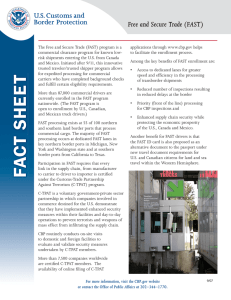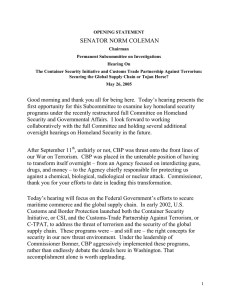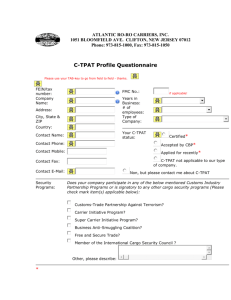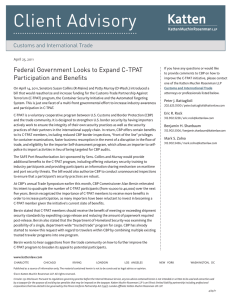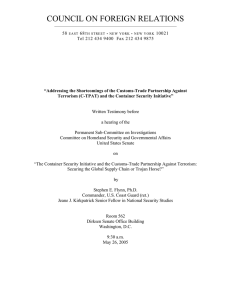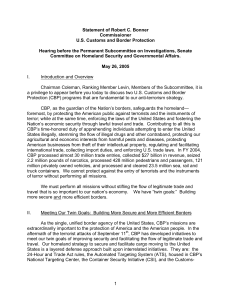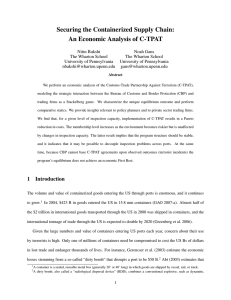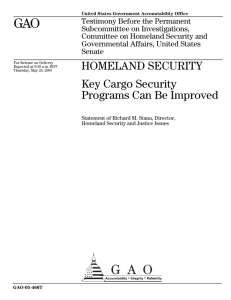United Nations Conference on Trade and Development CONTAINER SECURITY:
advertisement
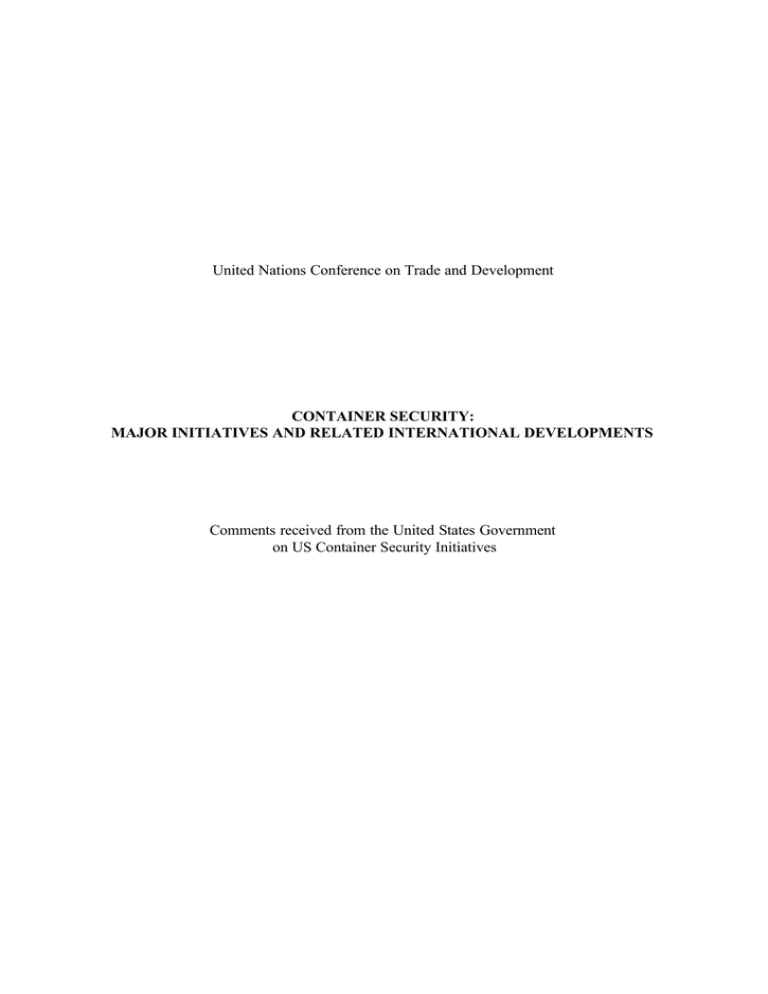
United Nations Conference on Trade and Development CONTAINER SECURITY: MAJOR INITIATIVES AND RELATED INTERNATIONAL DEVELOPMENTS Comments received from the United States Government on US Container Security Initiatives 2 United States Government Comments on February 2004 UNCTAD Report on Container Security 28 April 2004 Paragraph 6 Participants are not asked to "fill in" a C-TPAT Supply Chain Security Profile Questionnaire. Participants are required to conduct comprehensive internal/external security self- assessments of their supply chains and report back to CBP their findings, including identified strengths and weaknesses and action plan for improvement, via their Profile Questionnaire. Paragraph 7 Participants are no longer asked to simply communicate C-TPAT security guidelines to their business partners. They must begin conditioning their relationships on these guidelines and the security systems and processes of their business partners. Participants must demonstrate their compliance with each item of the appropriate C-TPAT Agreement through the submission of their Profile Questionnaire. Paragraph 8 Validations are not "surveys". The validation process is a foreign and domestic physical review by CBP and the C-TPAT participant to ensure that the supply chain security measures contained in the C-TPAT participant's security profile have been implemented and are being followed. Paragraph 9 Although there is no direct legal liability through C-TPAT, those participants found negligent or non-compliant with existing regulations will be penalized and prosecuted accordingly. Participants determined to be "not in compliance" with their C-TPAT Agreement may have their benefits terminated and/or may be removed from the program. Paragraph 14 In the event a cargo container suspected for potential weapons of mass destruction is targeted at a CSI port, it will be screened prior to being laden on a vessel destined to the US. Paragraph 15 Attached please find a list of operating CSI ports as of April 2004. Paragraph 22 A total of fourteen data elements are required and this is what was required prior to the 24hour rule. This should not be considered a large number. CBP merely clarified what was an acceptable and unacceptable definition for these data elements. 3 The final rule for the Trade Act of 2002 added two additional data elements for sea vessels date and time of sailing from the foreign location. This provides for a total of 16 data elements that are required for vessels. Paragraph 25 CBP believed that the old way of doing business no longer fit into today's business world. Due to the terrorist threat that exists, waiting until a vessel arrives to determine what is on board is insufficient for national security. Paragraph 29 The rule is the 24-hour rule, meaning CBP has 24- hours to review the cargo declaration information. Therefore, the carriers must allow 24-hours before loading the container. Additionally, in consultation with the World Shipping Council, the carrier industry determined that a "permission to load" message would put too much stress on their computer systems. In many cases, it would require the carriers to increase their system capabilities to allow for the increase in messages that would result if this type of messaging system were implemented. Therefore, a decision was agreed to that CBP would not provide for a "permission to load". Paragraph 30 If CBP has issued a "do not load" message to a carrier for a specific container, and that container is subsequently loaded, then the message is changed to a "do not unload". CBP issued the "do not load" message for a very specific reason. If the carrier fails to adhere to the message, that does not mean that the message is invalid. Paragraph 32 CBP does not release the cargo declaration information until after the vessel has arrived in the United States. Paragraph 34 CBP has been enforcing the 24-hour rule for approximately one and a half years and has just recently begun full enforcement of the Trade Act of 2002, which requires all cargo declaration information to be submitted electronically. CBP does not believe that there is an issue with not being able to carry out our targeting functions in a timely and efficient manner. Paragraph 53 C-TPAT membership is compris ed of thousands of medium and small-sized importers, brokers and carriers. In fact, the number of C-TPAT members that would be considered to be medium or small companies by most is greater than those considered to be large. Throughout CBP's twenty plus years of anti-smuggling/industry partnership program experience, we have become well aware of business' asset/resource allocation models and the need to balance security and efficiency. In fact, C-TPAT is specifically designed to be more than a supply chain security program. C-TPAT is also about enabling trade, improving supply 4 chain security and increasing supply chain performance. C-TPAT aids companies in optimizing their internal and external management of assets and functions while at the same time enhanc ing security. When administered together, enhanced security practices and procedures, and increased supply chain performance will mitigate the risk of loss, damage, and theft, and reduce the likelihood of the introduction of potentially dangerous elements into the global supply chain. C-TPAT members have provided public testimonials on the benefits of C-TPAT as over and above CBP's commitment to provide them with reduced cargo exams. Examples of these benefits include: • • • • • • Reduced cargo theft and pilferage Greater efficiency between internal and external functions Greater risk mitigation Stronger brand equity Improved asset utilization Greater supply chain integrity Paragraph 54 CSI ports are not the only ports from which goods may be shipped without import-related problems or delays. Cargo arriving from non-CSI ports is not delayed unnecessarily. It is reviewed and selected for examination in the U.S. based on risk analysis techniques similar to those employed at a CSI port. Thus, CSI ports are not more likely to attract more shippers, carriers, and freight forwarders. The CSI program will ensure that shipping lanes are reopened quickly should they be shut down due to another terrorist attack. Ports that purchase or update their container scanning systems usually see immediate benefits that result from the use of the upgraded equipment in the screening of their import shipments. Paragraphs 56-69 There is no evidence to date of the shifting of cargo shipments to CSI ports for cargo destined to the U.S. Paragraphs 60-61 On April 22, 2004, the US and the European Community (EC) signed an agreement to broaden and intensify Customs cooperation and mutual assistance in Customs matters. This agreement called for the prompt expansion of CBP's CSI program throughout the European Community, establishing minimum standards for risk management, and improving publicprivate partnerships to secure the international trade supply chain. Paragraphs 62-65 CBP has received no complaints from shipping companies, freight forwarders or non-vessel operating common carriers (NVOCCs) regarding the implementation of the 24-hour rule. In fact, the 24-hour rule enables shipping companies to better handle the logistics of lading ships 5 destined for the U.S. due to the adva nced filing of the manifests. Additionally, shipping companies and importers are receiving better manifest information, which enables them to control and secure their supply chain better. Ports in CSI Press Contact: 202-927-8727 Office of International Affairs: 202-927-0400 CSI is currently operational in the following port locations. In the North America: • Montreal, Vancouver & Halifax, Canada In Europe: • Rotterdam, The Netherlands • Bremerhaven & Hamburg, Germany • Antwerp, Belgium • Le Havre, France • Göteborg, Sweden • La Spezia and Genoa, Italy • Felixstowe, United Kingdom In Asia and the East: • Singapore • Yokohama, Japan • Hong Kong • Busan, South Korea • Port Kelang, Malaysia In Africa: • Durban, South Africa Future CSI ports include: In Europe: • Algeciras, Spain In Asia and the East: • Tokyo, Nagoya, Kobe and Osaka, Japan • Shanghai & Shenzhen, China • Laem Chabang, Thailand • Tanjung Pelepas, Malaysia • Colombo, Sri Lanka
